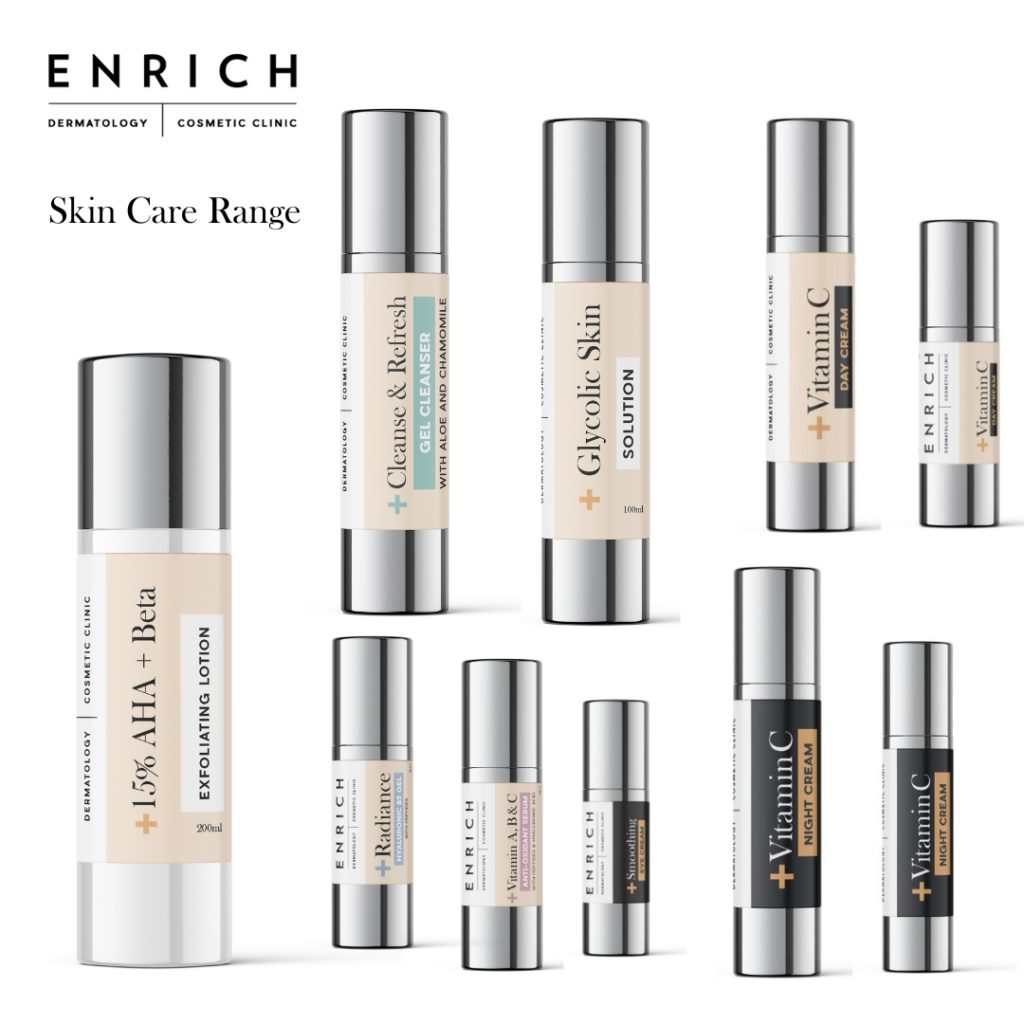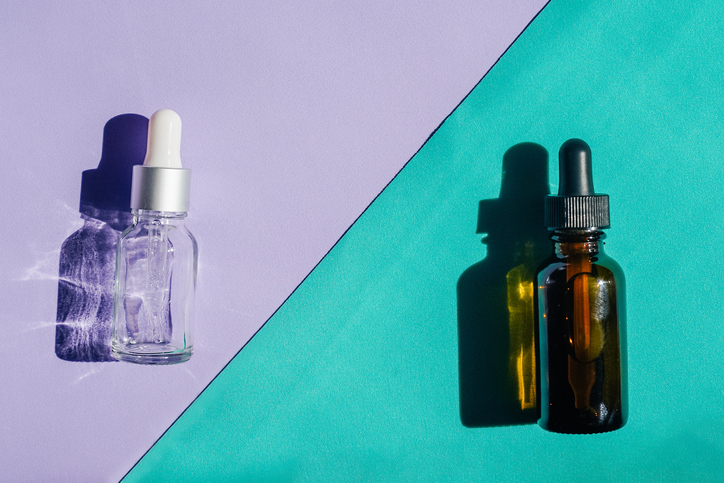Scars are the body’s natural way of healing wounds caused by injury, surgery, or skin conditions like acne. When the skin’s outermost layer, the epidermis, sustains damage, the body springs into action, generating collagen fibres to repair the wound. Unfortunately, these fibres contribute to the formation of new tissue, which, while functional, might look different from the surrounding skin, resulting in a scar.
While all scars are a natural part of the healing process, some may be more visually unappealing than others, leading to a desire for their removal or improvement.
Recognising the various types of scars is vital, as it guides your approach to their treatment and management. The most prevalent scar types include hypertrophic, keloid, atrophic, and contracture scars. Each type exhibits unique appearances, characteristics, and potential complications, making it essential to identify and address them with tailored treatments accurately.
Atrophic scars
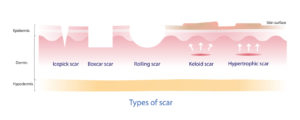
Atrophic scars are characterised by their sunken, depressed appearance and are typically found on the face, most commonly resulting from acne or other inflammatory skin conditions such as chickenpox.
These scars form when the skin loses collagen during the healing process, causing the skin to sink below the surrounding, healthy tissue.
Atrophic scars can be further classified into three subtypes: ice pick scars, boxcar scars, and rolling scars. Each subtype’s unique appearance and depth may require different treatment approaches.
Common treatments of atrophic scars
Dermabrasion
This treatment involves using a specialised device to exfoliate the skin’s surface, removing the top layer and stimulating the growth of new, healthy skin. This process can help improve the texture and appearance of atrophic scars.
Laser treatment
Various laser treatments, such as ablative and non-ablative lasers, can target damaged skin, promoting collagen production and the growth of healthy skin. But you may need multiple sessions to achieve optimal results.
Punch techniques
Punch excision, elevation and grafting are surgical techniques for treating deep atrophic scars. These methods involve removing the scarred tissue, repositioning it to the same level as the surrounding skin, or replacing it with a skin graft.
Fat transplantation
Also known as autologous fat transfer, this procedure involves extracting fat from one part of the body and injecting it into the atrophic scar to fill the depression and create a smoother, more even appearance. We do not do fat transfers at ENRICH Clinic.
Other tissue-augmenting agents
Dermal fillers made from biocompatible materials can be injected into atrophic scars to restore volume and improve their appearance temporarily. Depending on the filler used, the effects usually last several months to a year.
Needling
Skin needling, or collagen induction therapy, uses a device with tiny needles to create controlled micro-injuries in the skin. This process stimulates collagen production and can improve the appearance of atrophic scars over time.
Subcision
This minimally invasive surgical procedure involves using a needle or a specialised device to break the fibrous bands tethering the atrophic scar to the underlying tissue. By releasing these bands, subcision allows the scar to rise, improving its appearance and texture.
Limitations of treatments
Each procedure uniquely treats atrophic scars; some methods work better for specific scar types than others. In addition, atrophic scars can be quite diverse in type and depth, which means different treatments might be needed.
If you combine multiple procedures, you’re likely to see an improvement in many types of scars and even some fine textural irregularities that you wouldn’t get with just one method.
We recommend consulting with a qualified dermatologist or skin care professional to determine the most suitable treatment plan for your specific scar type and skin condition.
Hypertrophic scars
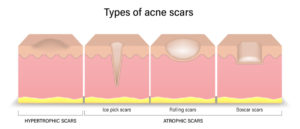
Hypertrophic scars are characterised by their raised, thickened appearance, which can be red or pink. They typically form within the boundaries of the original wound and result from an overproduction of collagen during the healing process.
Hypertrophic scars can develop after various injuries, including burns, cuts, surgical incisions and piercings. These scars may be itchy or painful and can take several months to years to mature and become less noticeable.
Common treatments
Silicone sheets and gels
These non-invasive treatments create a moist environment that helps soften and flatten hypertrophic scars. Silicone sheets can be cut to fit the scar’s size and should be worn for several hours each day, while silicone gels can be applied directly to the scar.
Corticosteroid injections
Injecting corticosteroids directly into the scar can help reduce inflammation, relieve pain and itchiness and improve the scar’s appearance by softening and flattening it. However, multiple injections may be required, depending on the severity of the scar.
Cryotherapy
This treatment involves freezing the scar tissue using liquid nitrogen, which helps reduce the scar’s thickness and size. A qualified healthcare professional should perform cryotherapy and may require multiple sessions.
Laser therapy
Various laser treatments can help improve the appearance of hypertrophic scars by targeting excess collagen, reducing redness and promoting the growth of healthy skin. Multiple sessions may be needed for optimal results.
Surgery
There are times when surgery might be needed to remove the scar or change how tension affects it. Generally, surgery is considered when other treatments haven’t worked out, mainly because surgery can also leave a scar behind. Surgery can be combined with other treatments to get the best results, giving you a more effective solution.
Limitations of treatments
How well these treatments work can depend on factors like your skin type, the scar’s severity, and your chosen treatment method. Also, you might need more than one treatment session to get your desired results.
It’s a good idea to chat with a qualified dermatologist or skin care professional who can help you figure out the best treatment plan for your specific scar and skin type.
Keloid scars
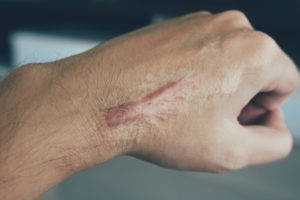
Keloid scars are a more severe form of raised scars extending beyond the original wound’s boundaries. These scars are firm, rubbery, and can be red or dark. They result from an overproduction of collagen and an abnormal healing response, which leads to excessive scar tissue growth.
Keloid scars can develop after various skin injuries, including burns, cuts, surgical incisions, piercings and even minor injuries like insect bites.
Genetics and skin type can predispose individuals to keloid formation. These scars may continue to grow over time and can cause discomfort, pain, or itchiness.
Common treatments
Corticosteroid injections
Corticosteroids, like triamcinolone or other medications can be directly injected into the keloid scar to reduce inflammation, flatten the scar and alleviate discomfort. Several injection sessions might be needed, spaced a few weeks apart.
Silicone sheets and gels
These sheets can be applied to the keloid scar to create a moist environment that aids healing. Silicone gel sheets can help flatten and soften the scar when worn for several hours each day and used consistently for several months.
Cryotherapy
Cryosurgery involves freezing the keloid scar with liquid nitrogen, which helps shrink and reduce its size. This method works best for small keloids and may require multiple sessions.
Laser therapy
Various laser treatments can help improve the appearance of keloid scars by targeting excess collagen, reducing redness, and promoting the growth of healthy skin. Multiple sessions may be needed to achieve optimal results.
Radiation treatments
Low-dose radiation therapy can be used after keloid surgery to help prevent the keloid from returning. It is typically administered within a day or two after surgery and should be done by an experienced radiation oncologist. We don’t perform radiation at ENRICH Clinic.
Ligature
In this treatment, a suture or thread is tied around the keloid scar, applying constant pressure and cutting off the blood supply to the scar tissue. Over time, the keloid shrinks and may fall off. You’ll need to tie a new surgical thread around the keloid every two to three weeks.
Limitations and potential complications of treatments
Treating keloids can be tricky, as there’s no one-size-fits-all solution. What works for one person might not work for someone else, and no treatment can guarantee that a keloid won’t return after it’s been treated.
That’s why dermatologists are working hard to understand better what causes keloids and develop more effective treatments.
If one of these new treatments might help you, your dermatologist may discuss it with you, especially if other treatments haven’t worked. How you care for your skin can make a difference, so be sure to follow any at-home care instructions your dermatologist provides. It’s also essential to stick to your treatment plan and get all the treatments your dermatologist recommends.
Also, if you’ve had a keloid in the past, you might develop another one in the future.
Contracture scars

Contracture scars are characterised by their tight, constricted appearance, which forms due to the skin and underlying tissue contracting during the healing process.
These scars are commonly associated with burns or other injuries that cause significant skin loss. As the skin heals, it pulls together and may restrict movement, especially when the scar is located near a joint.
In some cases, contracture scars can also cause discomfort or pain due to the tension created by the tightened skin.
Common treatments
Physical therapy and massage
Regular stretching exercises and massages can help improve the flexibility and mobility of the affected area. A physical therapist can recommend specific activities tailored to the scar’s location and severity.
Pressure dressing
Pressure garments or bandages can help reduce contracture scar formation by applying consistent pressure to the affected area. This treatment is most effective when initiated soon after the injury and worn continuously for several months.
Surgical intervention
In more severe cases, surgical procedures such as skin grafts, tissue expansion, or scar release may be necessary to improve the contracture scar’s range of motion and appearance. These procedures can involve transplanting healthy skin from another part of the body or using artificial skin substitutes.
Treatment limitations
In most cases, surgical intervention leads to significant improvement, but scar contractures can still happen even with the surgeon’s best efforts. Your doctor may suggest pressure and range-of-motion exercises for the best possible outcome for both function and appearance.
Stretch marks
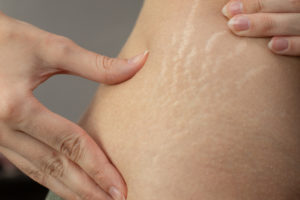
Stretch marks, or striae, are linear, narrow streaks or stripes that develop on the skin’s surface. They are usually pink, red, or purple when they first appear and may gradually fade to a silvery-white over time.
Stretch marks are caused by the rapid stretching of the skin, often due to growth spurts, pregnancy, rapid weight gain, or weightlifting. The stretching causes the dermis, the middle layer of skin, to tear, allowing the deeper layers of the skin to show through.
Common treatments
Retinoid cream
Topical retinoid creams, derived from vitamin A, can help stimulate collagen production and promote the healing of stretch marks. They work best on newer stretch marks and should be applied consistently for several months to achieve noticeable results.
It’s essential to consult with a dermatologist before using retinoid creams, especially if you’re pregnant or nursing, as they may not be suitable in these situations.
Light and laser therapies
Light and laser therapies, such as pulsed dye laser (PDL), fractional laser, and intense pulsed light (IPL) treatments, target the stretch marks to stimulate collagen production and improve their appearance.
These treatments can be effective for both newer and older stretch marks, but multiple sessions may be required for optimal results. Having these procedures done by a qualified professional is essential to minimise the risk of side effects and ensure the best outcome.
Microneedling
Microneedling is a minimally invasive procedure that uses tiny needles to create micro-injuries in the skin, stimulating the body’s natural healing process and collagen production. This treatment can help improve the texture and appearance of stretch marks over time. Typically, multiple microneedling sessions are necessary to achieve the desired results, and a qualified skincare professional should perform the procedure.
Limitations of treatments
Though not a medical concern, stretch marks can be a cosmetic issue for some people. While they are harmless and tend to fade over time, it’s important to note that treatments can only help them fade and may not make them disappear completely.
Several treatments are available to improve the appearance and texture of stretch marks, but no single treatment has been consistently more effective than others.
Remember that individual results may vary, and the effectiveness of each treatment can depend on factors like your skin type, the age of the stretch marks and the chosen treatment method. Therefore, it’s always a good idea to consult with a dermatologist or skincare professional to determine the most suitable treatment plan for your specific situation and to manage expectations regarding the outcome.
Surgical scars

Surgical scars are a natural result of the body’s healing process after a surgical incision or procedure. They occur when the skin and underlying tissues are cut or disrupted, prompting the body to produce collagen to repair the damage.
The appearance, size and shape of a surgical scar depend on factors such as the size and depth of the incision, the surgeon’s technique, the patient’s skin type, and the individual’s healing process. Surgical scars may initially appear red, raised, and firm but generally fade and flatten over time.
Common treatments
Proper wound care
Following the surgeon’s post-operative care instructions, including keeping the wound clean and dry, is crucial for minimising scar formation. It helps reduce the risk of infection and promotes optimal healing.
Silicone sheets and gels
Applying silicone sheets or gels to the surgical scar can help soften and flatten it while also reducing redness and itching. These treatments create a moist environment that aids in the healing process.
Sun protection
Protecting the surgical scar from sun exposure by using sunscreen or covering it with clothing is essential. UV rays can slow down the healing process and cause the scar to darken or become more noticeable.
Topical treatments
Over-the-counter or prescription creams, ointments, or gels containing ingredients like silicone, retinoids, or alpha hydroxy acids (AHAs) can help improve the appearance of surgical scars by promoting collagen production and skin cell turnover.
Polyurethane dressing
This can aid surgical scar healing by maintaining a moist environment, protecting the wound from infection, reducing friction and irritation, allowing gas exchange, and enabling easy monitoring due to their transparency. These factors improve healing, resulting in a better cosmetic outcome and less noticeable scars.
Limitations of treatments
Your active participation is crucial in achieving the best outcome in treating surgical scars. During postoperative visits, be attentive to signs of scar hypertrophy. These visits serve as an opportunity to learn and reinforce proper care practices. Remember, early intervention is key to manage hyperplastic responses.
Scar treatment at Enrich
The journey to scar treatment and management can be complex and overwhelming, with various factors influencing the success of treatments. Understanding these factors is vital in setting realistic expectations and finding the most effective approach to managing your scars.
To ensure you’re on the right path, we encourage you to consult an expert dermatologist specialising in scar management.
*Please note that ENRICH Clinic does not necessarily perform all of these treatments listed in this blog. This blog is informational only and does not constitute advice. Please contact your GP as an initial gateway to advice and treatment for scarring.







